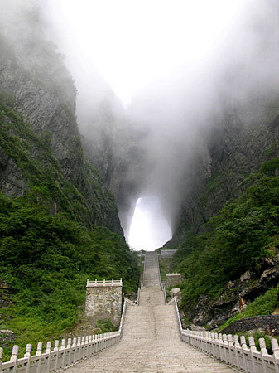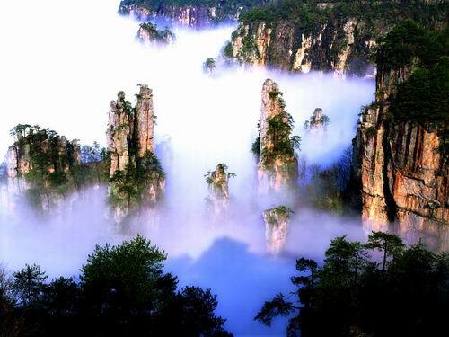Pandora is far, but Zhangjiajie is near
Zhangjiajie is situated in the northwest of Hunan Province, about 400 kilometers away from Changsha, the capital city of Hunan, covering a total area of 9,563 square kilometers, of which 76% are in mountainous areas. Out of its population of 1.62 million, almost 72% belong to ethnic minority groups, including Tujia, Bai and Miao nationalities.
Ever since the release of the Hollywood blockbuster “Avatar,” Zhangjiajie has been in the spotlight of the world. This is because “Hallelujah Mountain,” the spectacular mountain of Pandora, the fictional planet featured in “Avatar” was actually inspired by the “Southern Sky Column” of Zhangjiajie.
Famed for its fantastic mountains, pleasant streams, towering trees, deep valleys, marvelous caves and exuberant forests, Zhangjiajie is a perfect combination of the beauty of Guilin, the imposingness of Mount Huang, the perils of Mount Hua and the magnificence of Mount Tai
|
 |
After more than 20 years of development, tourism has become the leading industry of Zhangjiajie.
“The tourism revenue of Zhangjiajie accounts for more than 60 percent of the city’s GDP. It annually attracts more than 19 million visitors from both within and without China, so Zhangjiajie’s tourist market is relatively mature,” said Wang Jianjun, the director of Zhangjiajie’s Municipal Government Information Office.
As a tourist city, Zhangjiajie has fantastic transportation. Countless planes and trains bring visitors from around country to Zhangjiajie. In particular, the one-stop flight from Seoul to Zhangjiajie has been playing an important role in attracting Korean tourists, who have become the largest quotient of foreign visitors in Zhangjiajie. Travelling in Zhangjiajie, you can take a bus or taxi to the tourist spots without spending too much money. Small as Zhangjiajie is, if time permits, you can even stroll around its downtown area to enjoy some sightseeing.
Dayong Town, in downtown Zhangjiajie, is a cultural site with unique local culture, offering visitors the live performances, special products, costumes and foods of the local people. Visitors also can participate in whatever activities they would like to. As you stroll along the street in Dayong Town, some small but special stores will pull you in, and even if you don’t buy anything, the storekeepers will still give you a friendly smile. To enrich visitors’ light life, there is also a bar street in Dayong Town, showing that Zhangjiajie is not only beautiful but also modern.
When you walk out from Dayong Town and turn left for about 200 meters, you will find the Puguang Buddhist Temple (or White sheep Ancient Temple). This temple was built in an ancient and solemn style. No matter how noisy the outside is, when you step inside the temple, you will feel a sense of peace. The interior is filled with beautiful and fantastic designs drawn from various strains of Chinese mythology. Its stair railings are engraved with the Eight Immortals of Chinese Taoist legend. A well lies at the center of the floor, which is carved with an image of a dragon head, and the well is brilliantly designed to form the dragon’s eye. Building the well in the temple was not only convenient for the Buddhists’ lives, but also for the prevention of fires. To incorporate the well into a dragon head-shaped relief sculpture makes it harmonious with the temple.
Outside the temple, there is a lane at its right side full of booths for selling snacks. These treats include pickled vegetables, rice-flour noodles, porridge and many others. There is a special custom here that when you buy a bowl of porridge you can eat at least four pickled vegetables for free, if you don’t mind sharing these dishes with the strangers who sit at the same table as you.
Zhangjiajie is dotted with many hotels and restaurants, most of which have fair prices and good service. After a long day of travelling, a comfortable hotel and a delicious dinner can give you refreshment, giving you strength and energy for the next day’s journey.
If you are a first-time visitor to Zhangjiajie, don’t worry about getting lost. As the locals say, if you get lost you can always get help from Zhangjiajie’s policemen, who will help you find your destination.
Zhangjiajie is home to nearly 33 ethnic minority groups, each of them with its own distinctive folk culture. To have a smooth journey in Zhangjiajie, you must first learn the taboos of these ethnic people.
|
 |
The number 36 is considered taboo by the Tujia people because they believe “36” is associated with inexorable doom. On people’s 36th birthdays, they wear red underpants or a red belt round the waist to ward off bad luck or evil things.
In Tujia culture, men and women can neither sit at the same bench nor even sit face to face. Men are also forbidden from touching a woman’s waist, spitting in front of others or growing a beard.
Men’s heads are also very sacred in Tujia culture, so it is forbidden to touch them, as a male head is considered a symbol of dignity which must never be violated.
Aside from the fantastic mountains and wonderful landscape, Zhangjiajie also has many appealing folk cultures just waiting to be explored!
















